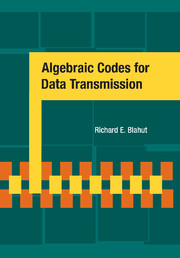Book contents
- Frontmatter
- Contents
- Preface
- Dedication
- 1 Introduction
- 2 Introduction to Algebra
- 3 Linear Block Codes
- 4 The Arithmetic of Galois Fields
- 5 Cyclic Codes
- 6 Codes Based on the Fourier Transform
- 7 Algorithms Based on the Fourier Transform
- 8 Implementation
- 9 Convolutional Codes
- 10 Beyond BCH Codes
- 11 Codes and Algorithms Based on Graphs
- 12 Performance of Error-Control Codes
- 13 Codes and Algorithms for Majority Decoding
- Bibliography
- Index
12 - Performance of Error-Control Codes
Published online by Cambridge University Press: 05 June 2012
- Frontmatter
- Contents
- Preface
- Dedication
- 1 Introduction
- 2 Introduction to Algebra
- 3 Linear Block Codes
- 4 The Arithmetic of Galois Fields
- 5 Cyclic Codes
- 6 Codes Based on the Fourier Transform
- 7 Algorithms Based on the Fourier Transform
- 8 Implementation
- 9 Convolutional Codes
- 10 Beyond BCH Codes
- 11 Codes and Algorithms Based on Graphs
- 12 Performance of Error-Control Codes
- 13 Codes and Algorithms for Majority Decoding
- Bibliography
- Index
Summary
In any engineering discipline, one looks for methods of solving a given class of problems and then for methods of quantifying the performance and complexity of those solutions. Accordingly, in this chapter, we shall study performance in terms of the composition structure of block codes, and the probabilities of decoding error and of decoding failure.
Later, after satisfactory methods are in hand, one turns to questions of optimality. Are these methods the best methods, and if not, in what ways and by how much are they inferior? To answer such questions, one needs to know how good are the known codes and how good are the best possible codes. Generally, we cannot answer either of these questions satisfactorily. Although for any given rate and blocklength, not too small, the best possible code is not known, a number of bounds are known – bounds beyond which no codes can exist, and bounds within which codes are sure to exist. We shall give some such bounds on the best possible codes later in this chapter. Knowledge of these bounds can deepen our understanding of the subject.
Weight distributions of block codes
If a linear block code has a minimum distance dmin, then we know that at least one codeword of weight dmin exists. Sometimes, we are not content with this single piece of information; we wish to know how many codewords have weight dmin, and what are the weights of the other codewords.
- Type
- Chapter
- Information
- Algebraic Codes for Data Transmission , pp. 375 - 417Publisher: Cambridge University PressPrint publication year: 2003



